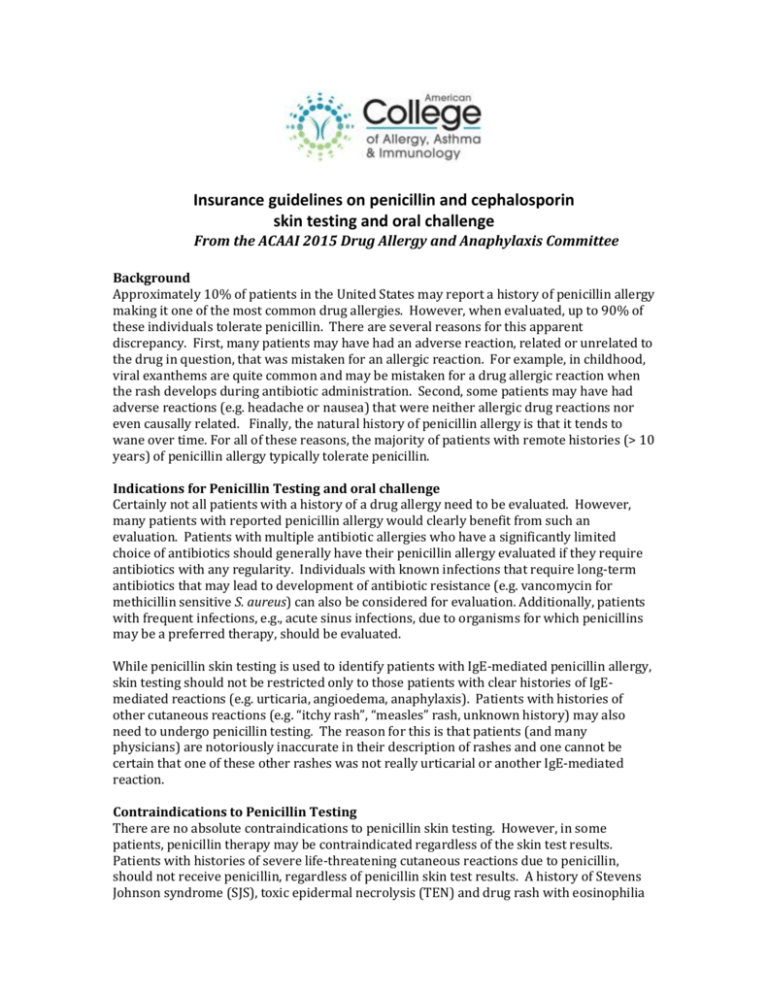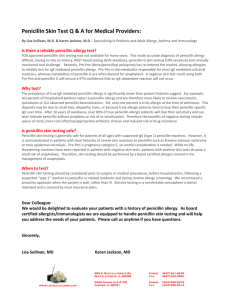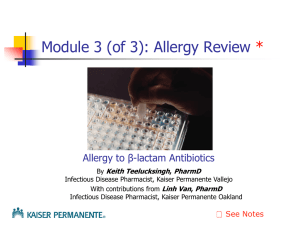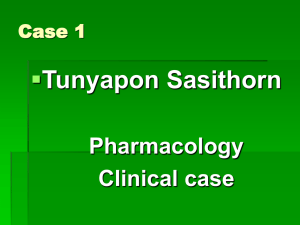Insurance guidelines on penicillin and cephalosporin skin
advertisement

Insurance guidelines on penicillin and cephalosporin skin testing and oral challenge From the ACAAI 2015 Drug Allergy and Anaphylaxis Committee Background Approximately 10% of patients in the United States may report a history of penicillin allergy making it one of the most common drug allergies. However, when evaluated, up to 90% of these individuals tolerate penicillin. There are several reasons for this apparent discrepancy. First, many patients may have had an adverse reaction, related or unrelated to the drug in question, that was mistaken for an allergic reaction. For example, in childhood, viral exanthems are quite common and may be mistaken for a drug allergic reaction when the rash develops during antibiotic administration. Second, some patients may have had adverse reactions (e.g. headache or nausea) that were neither allergic drug reactions nor even causally related. Finally, the natural history of penicillin allergy is that it tends to wane over time. For all of these reasons, the majority of patients with remote histories (> 10 years) of penicillin allergy typically tolerate penicillin. Indications for Penicillin Testing and oral challenge Certainly not all patients with a history of a drug allergy need to be evaluated. However, many patients with reported penicillin allergy would clearly benefit from such an evaluation. Patients with multiple antibiotic allergies who have a significantly limited choice of antibiotics should generally have their penicillin allergy evaluated if they require antibiotics with any regularity. Individuals with known infections that require long-term antibiotics that may lead to development of antibiotic resistance (e.g. vancomycin for methicillin sensitive S. aureus) can also be considered for evaluation. Additionally, patients with frequent infections, e.g., acute sinus infections, due to organisms for which penicillins may be a preferred therapy, should be evaluated. While penicillin skin testing is used to identify patients with IgE-mediated penicillin allergy, skin testing should not be restricted only to those patients with clear histories of IgEmediated reactions (e.g. urticaria, angioedema, anaphylaxis). Patients with histories of other cutaneous reactions (e.g. “itchy rash”, “measles” rash, unknown history) may also need to undergo penicillin testing. The reason for this is that patients (and many physicians) are notoriously inaccurate in their description of rashes and one cannot be certain that one of these other rashes was not really urticarial or another IgE-mediated reaction. Contraindications to Penicillin Testing There are no absolute contraindications to penicillin skin testing. However, in some patients, penicillin therapy may be contraindicated regardless of the skin test results. Patients with histories of severe life-threatening cutaneous reactions due to penicillin, should not receive penicillin, regardless of penicillin skin test results. A history of Stevens Johnson syndrome (SJS), toxic epidermal necrolysis (TEN) and drug rash with eosinophilia and systemic symptoms (DRESS) to penicillin are examples of contraindications of treatment with penicillin. Other less common penicillin drug allergic reactions may not be IgE mediated and skin testing would not be of any value. Drug-induced fever, hepatitis, hemolytic anemia, and vasculitis are examples where skin testing would not offer useful information as to the safety of reintroducing penicillin. When to Perform Penicillin Skin Tests It is best to perform penicillin skin testing electively so that the results are available prior to any need for penicillin and therapy is not delayed. The main concern with this approach has often been resensitization. Several recent studies have shown that the risk for resensitization to oral courses of penicillin is rare. Therefore, penicillin skin testing does not routinely need to be repeated in patients with a history of penicillin allergy who have tolerated one or more courses of oral penicillin. When penicillin testing is delayed until there is an urgent need for the drug, there is added cost and associated increased patient risks due to delayed treatment. What to Do with Penicillin Skin Test Results Since there is a small risk of reactions in patients who are penicillin skin test negative, we would recommend a confirmatory penicillin challenge. In the majority of patients who are being tested, the history is remote, and the reaction is non-anaphylactic and therefore the pre-test likelihood of penicillin allergy is low. For these patients, we administer a 2- dose test challenge, giving a total of amoxicillin 500 mg and observe for an hour after the final dose. We use amoxicillin as it covers both penicillin and side-chains of aminopenicillins. Following negative skin tests and a negative challenge, the patient is advised that he/she may take penicillin in the future if needed. For the rare patient in which the pre-test probability for penicillin allergy is high and the skin test is negative, a multi-step graded dose challenge to amoxicillin may be more appropriate. For patients with a positive penicillin skin test, penicillin avoidance is recommended. If penicillin therapy is required, a penicillin desensitization can be performed. What to do when a cephalosporin is needed but there is risk of an allergic reaction Allergic reactions to cephalosporins are much less common than are those to penicillins, however, they are not rare. When a patient with reported PCN allergy requires a cephalosporin, it is recommended to test to PCN and complete an oral challenge using Amoxicillin as outlined above. If the patient is negative on both skin testing and challenge, they should be able to safely take cephalosporins. When a patient has had an allergic reaction to one cephalosporin and needs to take another cephalosporin, it is best to conduct skin testing and an oral challenge with an unrelated cephalosporin that is appropriate for treatment of the medical condition. As with penicillin testing, there are times, e.g., multiple drug allergies, when testing should be completed when the before there is an urgent need for the medication. When a patient with a reported cephalosporin allergy requires penicillin, it is best to complete skin testing and oral challenge to penicillin as discuss above. This testing procedure is best conducted before there is an urgent need for penicillin. A conservative estimate of penicillin allergy is less than one percent, but patients allege it 10-15 times that number, making it a very common warning on our charts. When taking a patient history or transferring it from a questionnaire, most of us never question it. If the patient says they are allergic, we list it, despite the fact that many patients cannot remember the circumstances. When explored, 90% of those are found not to be allergic after testing and challenge with penicillin. Physicians have been reluctant to challenge the patients’ assumptions, but as the list of antibiotic sensitivities and complications accumulate we often become frustrated and worried. The extreme caution through the years was well justified since legitimate penicillin allergy is a reproducible event that can result in life threatening anaphylaxis on re-administration, usually at the hand of a prescribing physician. The credo of, “First do no harm” is entrenched in us. Resulting avoidance of penicillin and cross reactive beta lactams has been the dogma for several decades, in part due to the readily available multitude of antibiotic alternatives and recent shortages in reagents for penicillin testing in a reliable manner. But, this landscape is changing. It seems that the conservative avoidance strategy, itself, may have ill-toward effects. While testing and medication challenge was usually reserved for only essential or necessary penicillin use, now elective testing is gaining favor for multiple reasons. While reliable commercial penicillin testing agent have been available since FDA approval in 2009, no commercial production has been available until recently making penicillin evaluations extremely accurate. In the literature, many have noted the inappropriate overuse of “penicillin allergy” for decades and commented on the resounding effects to patients, costs, and antibiotic stewardship. Recent evidence continues to reinforce that we are creating undue risk to patients and costs to the system with our current practice – increased infections (like clostridium dificile, methacylin resistant staphylococcus aureus, and vancomycin resistant enterococcus), increased hospitalization time for those with penicillin allergy, impaired optimal treatment, increased use of second line antibiotics (clindamycin, fluoroquinolones, and vancomycin), and overall increased costs. Removing the label “PCN Allergy” from the 90% of patients we know are not truly allergic This involves a careful review of the history and characterization of the original reaction followed by penicillin testing to look for allergic sensitivity, if indicated. There are several ways to do this, but utilizing skin prick and intradermal tests to major and minor penicillin determinants provides close to 100% confidence that the patient can be treated without a life threatening reaction. Proceeding to an oral challenge with a beta lactam medication after negative testing further demonstrates tolerance. This procedure provides an opportunity for beta lactam use in these patients going forward, and to removing the allergic designation from their medical records. Each “penicillin allergic” patient reclassified represents a tremendous financial savings to the system, and a significant safety impact for the patient. Suggested References: 1. Solensky R, Khan DA, Bernstein IL, et al. Drug Allergy: an updated practice parameter. Ann Allergy Asthma Immunol 2010;105:273.e1-e78. 2. Khan DA, Solensky R. Drug Allergy. J Allergy Clin Immunol 2010 125:S126-37. 3. Green GR, Rosenblum AH, Sweet LC. Evaluation of penicillin hypersensitivity: value of clinical history and skin testing with penicilloyl-polylysine and penicillin G. J Allergy Clin Immunol1977;60:339-45. 4. J Allergy Clin Immunol. 2014 Mar;133(3):790-6. doi: 10.1016/j.jaci.2013.09.021. Epub 2013 Nov 1. Health care use and serious infection prevalence associated with penicillin "allergy" in hospitalized patients: A cohort study. Macy E1, Contreras R2. 5. Pharmacotherapy. 2013 Aug;33(8):856-67. doi: 10.1002/phar.1288. Epub 2013 May 26. Penicillin skin testing: potential implications for antimicrobial stewardship. Unger NR1, Gauthier TP, Cheung LW 6. J Allergy Clin Immunol. 1998 Aug;102(2):281-5. Elective penicillin skin testing and amoxicillin challenge: effect on outpatient antibiotic use, cost, and clinical outcomes. Macy E. 7. J Allergy Clin Immunol Pract. 2013 May-Jun;1(3):252-7. doi: 10.1016/j.jaip.2013.01.006. Epub 2013 Feb 14. Treatment of patients with a history of penicillin allergy in a large tertiary-care academic hospital. Picard M1, Bégin P2, Bouchard H3, Cloutier J3, Lacombe-Barrios J4, Paradis J4, Des Roches A5, Laufer B3, Paradis L4. 8. Stephanie J. Fox, MD; Miguel A. Park, MD. Penicillin Skin Testing Is a Safe and Effective Tool for Evaluating Penicillin Allergy in the Pediatric Population. The Journal of Allergy and Clinical Immunology: In Practice Volume 2, Issue 4, Pages 439–444, July–August, 2014 9. Ann Allergy Asthma Immunol. 2010 Oct;105(4):259-273. doi: 10.1016/j.anai.2010.08.002. Drug allergy: an updated practice parameter. Joint Task Force on Practice Parameters; American Academy of Allergy, Asthma and Immunology; American College of Allergy, Asthma and Immunology; Joint Council of Allergy, Asthma and Immunology.









